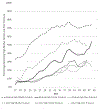Demographic predictors of objectification theory and tripartite influence model constructs: The U.S. Body Project I
- PMID: 34972020
- PMCID: PMC9750803
- DOI: 10.1016/j.bodyim.2021.12.012
Demographic predictors of objectification theory and tripartite influence model constructs: The U.S. Body Project I
Abstract
We examined how demographic factors (gender, sexual orientation, racial group, age, body mass) were linked to measures of sociocultural appearance concerns derived from objectification theory and the tripartite influence model (McKinley & Hyde, 1996; Schaefer et al., 2015) among 11,620 adults. Men were less likely than women to report high body surveillance, thin-ideal internalization, appearance-related media pressures, and family pressures; did not differ in peer pressures; and reported greater muscle/athletic internalization. Both men and women expressed greater desire for their bodies to look "very lean" than to look "very thin". Compared to gay men, heterosexual men reported lower body surveillance, thin-ideal internalization, peer pressures, and media pressures. Black women reported lower thin-ideal internalization than White, Hispanic, and Asian women, whereas Asian women reported greater family pressures. Being younger and having higher BMIs were associated with greater sociocultural appearance concerns across most measures. The variation in prevalence of sociocultural appearance concerns across these demographic groups highlights the need for interventions.
Keywords: Body image; Gender; Objectification theory; Sexual orientation; Tripartite influence model.
Copyright © 2021 Elsevier Ltd. All rights reserved.
Conflict of interest statement
Conflict of interest statement There are no conflicts of interest.
Figures

Similar articles
-
Racial identity differences in pathways from sociocultural and objectification constructs to body satisfaction: The U.S. Body Project I.Body Image. 2022 Jun;41:140-155. doi: 10.1016/j.bodyim.2022.01.019. Epub 2022 Mar 4. Body Image. 2022. PMID: 35255272 Free PMC article.
-
Pathways from sociocultural and objectification constructs to body satisfaction among women: The U.S. Body Project I.Body Image. 2022 Jun;41:195-208. doi: 10.1016/j.bodyim.2022.02.001. Epub 2022 Mar 14. Body Image. 2022. PMID: 35299008 Free PMC article.
-
Sexual orientation differences in pathways from sociocultural and objectification constructs to body satisfaction: The U.S. Body Project I.Body Image. 2022 Jun;41:181-194. doi: 10.1016/j.bodyim.2022.02.002. Epub 2022 Mar 7. Body Image. 2022. PMID: 35272100 Free PMC article.
-
Body image and internalization of appearance ideals in Black women: An update and call for culturally-sensitive research.Body Image. 2021 Dec;39:313-327. doi: 10.1016/j.bodyim.2021.10.005. Epub 2021 Nov 5. Body Image. 2021. PMID: 34749264 Review.
-
Gender and Media Representations: A Review of the Literature on Gender Stereotypes, Objectification and Sexualization.Int J Environ Res Public Health. 2023 May 9;20(10):5770. doi: 10.3390/ijerph20105770. Int J Environ Res Public Health. 2023. PMID: 37239498 Free PMC article. Review.
Cited by
-
The Mental "Weight" of Discrimination: The Relationship between Perceived Interpersonal Weight Discrimination and Suicidality in the United States.J Health Soc Behav. 2023 Dec;64(4):610-625. doi: 10.1177/00221465231200634. Epub 2023 Sep 30. J Health Soc Behav. 2023. PMID: 37776190 Free PMC article.
-
Examining body appreciation in six countries: The impact of age and sociocultural pressure.PLoS One. 2024 Jul 31;19(7):e0306913. doi: 10.1371/journal.pone.0306913. eCollection 2024. PLoS One. 2024. PMID: 39083477 Free PMC article.
-
Social cure model: testing the link between identity centrality and body appreciation in diverse sexual orientation and gender identity groups.Int J Equity Health. 2024 Sep 18;23(1):185. doi: 10.1186/s12939-024-02268-3. Int J Equity Health. 2024. PMID: 39294616 Free PMC article.
-
Demographic predictors of body image satisfaction: The U.S. Body Project I.Body Image. 2022 Jun;41:17-31. doi: 10.1016/j.bodyim.2022.01.011. Epub 2022 Feb 24. Body Image. 2022. PMID: 35220024 Free PMC article.
-
Beyond the Mirror: Future Orientation Reduces Self-Objectification.Arch Sex Behav. 2025 Apr;54(4):1497-1507. doi: 10.1007/s10508-025-03116-3. Epub 2025 Feb 27. Arch Sex Behav. 2025. PMID: 40014239
References
-
- Austin SB, Ziyadeh N, Kahn JA, Camargo CA Jr., Colditz GA, & Field AE (2004). Sexual orientation, weight concerns, and eating-disordered behaviors in adolescent girls and boys. Journal of the American Academy of Child & Adolescent Psychiatry, 43, 1115–1123. 10.1097/01.chi.0000131139.93862.10 - DOI - PubMed
-
- Bergeron SM, & Senn CY (1998). Body image and sociocultural norms: A comparison of heterosexual and lesbian women. Psychology of Women Quarterly, 22, 385–401. 10.1111/j.1471-6402.1998.tb00164.x - DOI
-
- Berinsky AJ, Huber GA, & Lenz GS (2012). Evaluating online labor markets for experimental research: Amazon.com’s Mechanical Turk. Political Analysis, 20, 351–368. 10.1093/pan/mpr057 - DOI
MeSH terms
Grants and funding
LinkOut - more resources
Full Text Sources

